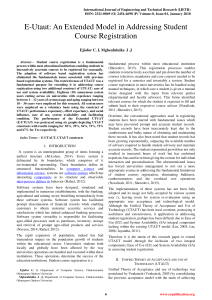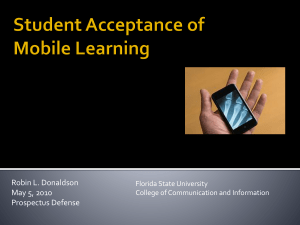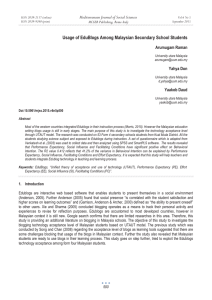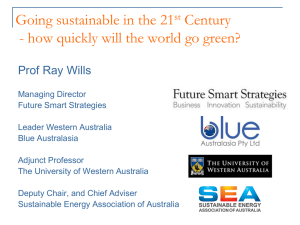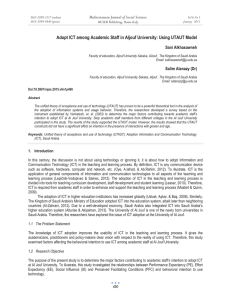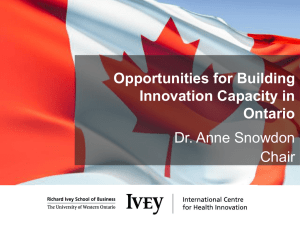UWCISA-presentation-Gonzalez-Sharma-Galletta
advertisement
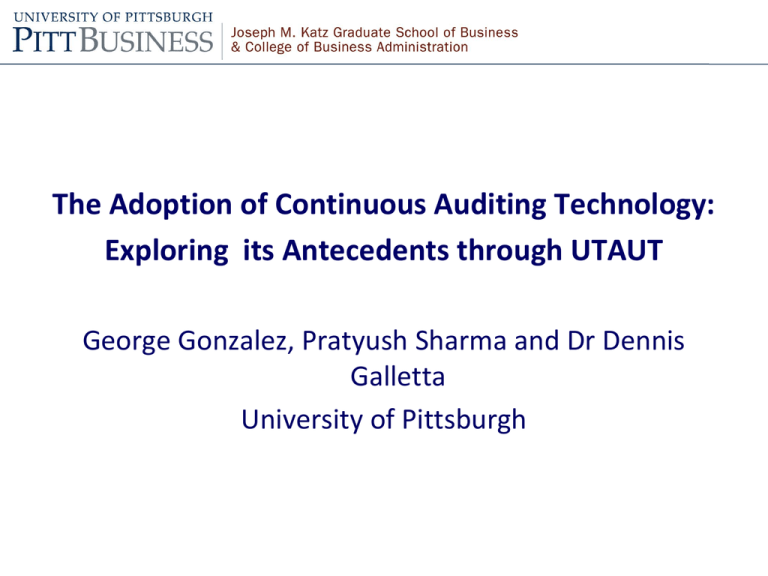
The Adoption of Continuous Auditing Technology: Exploring its Antecedents through UTAUT George Gonzalez, Pratyush Sharma and Dr Dennis Galletta University of Pittsburgh 1. 2. 3. 4. 5. Motivation Theory Research Design Results Conclusion 2 Motivation • Continuous Auditing (CA) about two decades old (Groomer and Murthy 1989; Vasarhelyi et al. 1991). • Widely touted as a control tool. • Adoption so far mainly limited to internal auditors (Chan and Vasarhelyi 2011). 3 Motivation (cont’d) • Practitioner surveys: current adoption low-tomoderate, but planned adoption high (PwC 2006; KPMG 2010; Grant Thornton 2010). • Everyone seems agree that CA would be a great idea, but actual adoption continues to lag. Why? 4 1. 2. 3. 4. 5. Motivation Theory Research Design Results Conclusion 5 Theory • Unified Theory of Acceptance and Use of Technology (UTAUT) (Venkatesh et al. 2003) • An IS framework for assessing an individual’s intention to use an IS technology. • UTAUT is refinement of its successor, Technology Acceptance Model (TAM). 6 Theory (cont’d) UTAUT’s four antecedents to intentions to use: • Effort expectancy (EE) • Performance expectancy (PE) • Social influence (SI) • Facilitating conditions (FC) 7 Theory (cont’d) • We adopt UTAUT to explore the perceptions of potential CA users embedded in organizations. • We explore the relationship between their current perceptions about CA technology and their intentions to use it. 8 Effort Expectancy Research Model + Performance Expectancy + Adoption Facilitating Conditions + + Social Influence Sales Voluntary 1. 2. 3. 4. 5. Motivation Theory Research Design Results Conclusion 10 Research Design • Survey of Institute of Management Accountants (IMA) members. • IMA members working in internal auditing, risk management, information systems or general accounting. 11 Research Design (cont’d) • Survey questions on UTAUT model antecedents: PE, EE, SI, FC • Survey questions adopted from UTAUT • Control variable questions: – Annual sales – Voluntariness of use 12 Research Design (cont’d) • Partial least squares based Structural Equation Modeling (PLS-SEM) for analysis of survey responses. • Based on PLS-SEM analysis results, we determine which antecedents (PE, EE, SI, FC) are key for the adoption of CA technology. 13 1. 2. 3. 4. 5. Motivation Theory Research Design Results Conclusion 14 Descriptives • 9,013 surveys e-mailed worldwide • 210 usable responses (2.33% response rate) • geographic breakdown: – – – – – North America 61% Middle East 27% Asia 6% Europe 4% other regions 2% 15 Key Findings • Perception of Effort Expectancy strongly predicts intention to use CA. • Additionally, perception of Social Influence also strongly predicts intention to use CA. • Perceptions of Performance Expectancy and Facilitating Conditions are not significant predictors of intention to use. 16 1. 2. 3. 4. 5. Motivation Theory Research Design Results Conclusion 17 Implications • Build positive perceptions of Effort Expectancy among potential users • Build positive perceptions of Social Influence among potential users • To accomplish this… 18 Implications Educate potential users regarding CA system’s: • Reasonable learning curve • Ease of user interaction • Ease of use • Reduction in work effort 19 Implications • Finally, it is critical for top management to endorse CA technology… • And support its use 20
